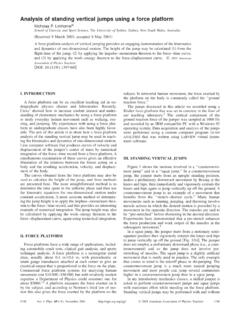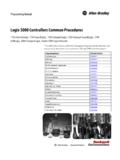Transcription of Programmable logic controller - Brunel University …
1 Programmable logic controller 1. Programmable logic controller (PLC). Alireza Mousavi, Morad Danishvar and Alexandre Spieser 1. Introduction PLC is a digital computer used for automation of electromechanical processes in plants. The PLC is designed for multiple inputs and outputs arrangements, so we can get the data from the sensors, work with it and command the actuators. The first Programmable logic controller (PLC) was developed by a group of engineers at General Motors in 1968, when the company were looking for an alternative to replace complex relay control systems.
2 The new control system had to meet the following requirements: Simple programming Program changes without system intervention (no internal rewiring). Smaller, cheaper and more reliable than corresponding relay control systems Simple, low cost maintenance 2. PLC Components Fig 1 illustrates the system components of a PLC. 2. Figure 1. PLC components The function of an input module is to convert incoming signals into signals that can be processed by the PLC, and to pass those signals to the central control unit. The reverse task is performed by an output module. This converts the PLC signal into signals suitable to operate and invoke the plant actuators.
3 The actual processing of the signals is undertaken in the central control unit and with respect to the program stored in the memory. The programs and operational routines in a PLC can be created in various ways: The "Ladder diagram" strongly resembles a schematic diagram of relay logic . The other features are function block diagram (FBD) and statement list (STL). Fig 2 shows an example presented in different ways using controlLogix development tool. Depending on how the central control unit is connected to the input and output modules, various versions of the PLC.
4 Can be put together. For example, compact PLCs (input module, central control unit and output module in one housing) or modular PLCs. 3. Fig 2. Different PLC programming structures 3. Basic Procedure for PLC programming: Figure 3 describes the basic procedure for programming PLC. Designing the solution to the automation task Creating a project Configuring the hardware Creating a program Transferring the program to the CPU and debugging Fig 3. Basic procedure for PLC programming 4. ALLEN BRADLEY PLC: CompactLogix L32E. Allen-Bradley is the brand-name of a line of Factory Automation Equipment manufactured by Rockwell Automation.
5 The connection between the controller and the computer is either serial cable or Ethernet cable. We will explain the steps to setting up a project on PLC Allen Bradley using RS logix5000 software. Configuring the hardware Connect the controller via the Serial Port and Configure the Serial Driver: Begin with connecting the serial cable to the PC on one side and the controller on the other side. Next configure a connection. To configure a connection, we use the RSLinx Classic Lite software. For the serial communication we need to configure the RS-232 DF1 Device driver.
6 1. Choose configure driver. 2. From the Available Driver Types pull-down menu, choose the RS-232 DF1 Device driver. 3. Click Add New to add the driver. 4. The Add New RSLinx Driver dialog box appears. 5. Specify the driver name and click OK. The configure dialog box appears: Figure : Configuring Communication 5. Specify the serial port settings. o From the Com Port pull-down menu, choose the serial port on the workstation to that the cable is connected to ( Port 1, Port 2, ). o From the Device pull-down menu, choose Logix 5550-Serial Port. o Click Auto-Configure.
7 Verify that the Auto-Configuration was successful. If it doesn't work, check if you have selected the correct port. Configure the I/O modules: In the next steps we intend to configure the physical modules in the project. In order to establish a communication between the controller and an I/O module in the system, add the module to the I/O Configuration folder of the controller . When you add a module, you also define a specific configuration for the module. Figure 4. Configuring and adding modules to the project Creating a program a. Ladder logic programming In this section we will cover some of the basic and most used instructions in PLC.
8 Programming. Following the explanations on how to program the controller , we will then have a look at how we can implement and use those instructions in real life applications. 6. Figure 5 shows a PLC ladder program. A PLC ladder program is a planned set of instructions resembling a hardwired ladder diagram. It consists of a line (L) power rail and a neutral (N). power rail between which one or more rungs are inserted. Each individual rung contains one or more input instructions on its left-hand (L power rail). side, and a single output instruction or several output instructions placed in parallel on its right-hand (N power rail) side.
9 In Figure 5, for example, the instructions Examine If Closed (XIC) and Examine If Open (XIO) are input instructions analogous to relay contacts. On the other hand, the instruction Output Energize (OTE) is an output instruction analogous to a relay coil. The PLC ladder program is the main component of the project you download to a PLC. The PLC uses this program to interpret the signals present at its inputs and operate its outputs accordingly. Fig 5. PLC ladder program b. Logical Continuity. During PLC operations, and in order to determine whether these PLC inputs are activated or deactivated, the processor reads (scans) the status of the signals applied to the PLC inputs, through the PLC internal input interface, The processor then updates the input data file (data file I1) bits accordingly.
10 The processor then evaluates each rung of the ladder program 7. individually, updates the timer, binary status, counter, and control data, and then modifies the output data file (data file O0) bits accordingly. The output data file bits are used to energize or de-energize relays in the PLC internal output interface, causing these relays to apply or remove power to/from the devices connected to the PLC output interface terminals. To evaluate a rung, that is, to determine if the rung is true or false, the processor verifies if a continuous left-to-right path of true input instructions exists between the line (L) and neutral (N) power rails.






